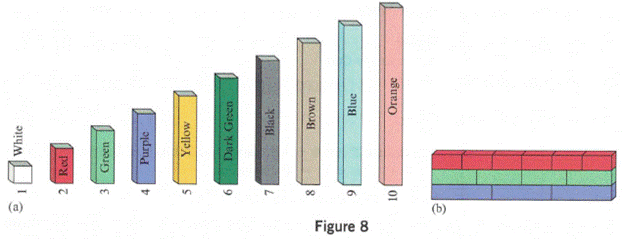
Concept explainers
NOW TRY THIS 4
Colored rods are used in the elementary school classroom to teach many concepts. The rods vary in length from
a. What rods can be used to form a one-color train for
b. What one-color trains are possible for
c. How many one-color trains of two or more rods are possible for each prime number greater than
d. In figure

Want to see the full answer?
Check out a sample textbook solution
Chapter 4 Solutions
A PROBLEM SOLVING APPROACH TO MATHEMATI
- 1 What is the area of triangle ABC? 12 60° 60° A D B A 6√√3 square units B 18√3 square units 36√3 square units D 72√3 square unitsarrow_forwardEach answer must be justified and all your work should appear. You will be marked on the quality of your explanations. You can discuss the problems with classmates, but you should write your solutions sepa- rately (meaning that you cannot copy the same solution from a joint blackboard, for exam- ple). Your work should be submitted on Moodle, before February 7 at 5 pm. 1. True or false: (a) if E is a subspace of V, then dim(E) + dim(E) = dim(V) (b) Let {i, n} be a basis of the vector space V, where v₁,..., Un are all eigen- vectors for both the matrix A and the matrix B. Then, any eigenvector of A is an eigenvector of B. Justify. 2. Apply Gram-Schmidt orthogonalization to the system of vectors {(1,2,-2), (1, −1, 4), (2, 1, 1)}. 3. Suppose P is the orthogonal projection onto a subspace E, and Q is the orthogonal projection onto the orthogonal complement E. (a) The combinations of projections P+Q and PQ correspond to well-known oper- ators. What are they? Justify your answer. (b) Show…arrow_forwardpleasd dont use chat gptarrow_forward
- 1. True or false: (a) if E is a subspace of V, then dim(E) + dim(E+) = dim(V) (b) Let {i, n} be a basis of the vector space V, where vi,..., are all eigen- vectors for both the matrix A and the matrix B. Then, any eigenvector of A is an eigenvector of B. Justify. 2. Apply Gram-Schmidt orthogonalization to the system of vectors {(1, 2, -2), (1, −1, 4), (2, 1, 1)}. 3. Suppose P is the orthogonal projection onto a subspace E, and Q is the orthogonal projection onto the orthogonal complement E. (a) The combinations of projections P+Q and PQ correspond to well-known oper- ators. What are they? Justify your answer. (b) Show that P - Q is its own inverse. 4. Show that the Frobenius product on n x n-matrices, (A, B) = = Tr(B*A), is an inner product, where B* denotes the Hermitian adjoint of B. 5. Show that if A and B are two n x n-matrices for which {1,..., n} is a basis of eigen- vectors (for both A and B), then AB = BA. Remark: It is also true that if AB = BA, then there exists a common…arrow_forwardQuestion 1. Let f: XY and g: Y Z be two functions. Prove that (1) if go f is injective, then f is injective; (2) if go f is surjective, then g is surjective. Question 2. Prove or disprove: (1) The set X = {k € Z} is countable. (2) The set X = {k EZ,nЄN} is countable. (3) The set X = R\Q = {x ER2 countable. Q} (the set of all irrational numbers) is (4) The set X = {p.√2pQ} is countable. (5) The interval X = [0,1] is countable. Question 3. Let X = {f|f: N→ N}, the set of all functions from N to N. Prove that X is uncountable. Extra practice (not to be submitted). Question. Prove the following by induction. (1) For any nЄN, 1+3+5++2n-1 n². (2) For any nЄ N, 1+2+3++ n = n(n+1). Question. Write explicitly a function f: Nx N N which is bijective.arrow_forward3. Suppose P is the orthogonal projection onto a subspace E, and Q is the orthogonal projection onto the orthogonal complement E. (a) The combinations of projections P+Q and PQ correspond to well-known oper- ators. What are they? Justify your answer. (b) Show that P - Q is its own inverse.arrow_forward
- Are natural logarithms used in real life ? How ? Can u give me two or three ways we can use them. Thanksarrow_forwardBy using the numbers -5;-3,-0,1;6 and 8 once, find 30arrow_forwardShow that the Laplace equation in Cartesian coordinates: J²u J²u + = 0 მx2 Jy2 can be reduced to the following form in cylindrical polar coordinates: 湯( ди 1 8²u + Or 7,2 მ)2 = 0.arrow_forward
- Draw the following graph on the interval πT 5π < x < x≤ 2 2 y = 2 cos(3(x-77)) +3 6+ 5 4- 3 2 1 /2 -π/3 -π/6 Clear All Draw: /6 π/3 π/2 2/3 5/6 x 7/6 4/3 3/2 5/311/6 2 13/67/3 5 Question Help: Video Submit Question Jump to Answerarrow_forwardDetermine the moment about the origin O of the force F4i-3j+5k that acts at a Point A. Assume that the position vector of A is (a) r =2i+3j-4k, (b) r=-8i+6j-10k, (c) r=8i-6j+5karrow_forwardPlease answer the questionsarrow_forward
 Algebra and Trigonometry (MindTap Course List)AlgebraISBN:9781305071742Author:James Stewart, Lothar Redlin, Saleem WatsonPublisher:Cengage Learning
Algebra and Trigonometry (MindTap Course List)AlgebraISBN:9781305071742Author:James Stewart, Lothar Redlin, Saleem WatsonPublisher:Cengage Learning College AlgebraAlgebraISBN:9781305115545Author:James Stewart, Lothar Redlin, Saleem WatsonPublisher:Cengage Learning
College AlgebraAlgebraISBN:9781305115545Author:James Stewart, Lothar Redlin, Saleem WatsonPublisher:Cengage Learning
 Algebra: Structure And Method, Book 1AlgebraISBN:9780395977224Author:Richard G. Brown, Mary P. Dolciani, Robert H. Sorgenfrey, William L. ColePublisher:McDougal Littell
Algebra: Structure And Method, Book 1AlgebraISBN:9780395977224Author:Richard G. Brown, Mary P. Dolciani, Robert H. Sorgenfrey, William L. ColePublisher:McDougal Littell College Algebra (MindTap Course List)AlgebraISBN:9781305652231Author:R. David Gustafson, Jeff HughesPublisher:Cengage Learning
College Algebra (MindTap Course List)AlgebraISBN:9781305652231Author:R. David Gustafson, Jeff HughesPublisher:Cengage Learning





